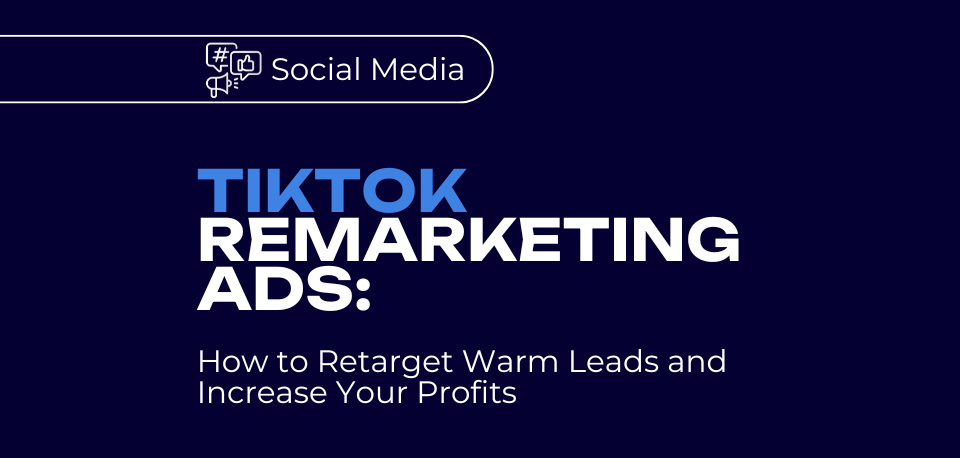Looking for tips on how you can use TikTok remarketing ads to re-engage prospects who could turn into loyal customers? We get it. Today’s prospects are busy, and distracted by countless things. All it takes is for something else to grab their attention when they’re adding products to their carts, and you could miss out on a crucial sale.
In fact, nearly 70% of customers “abandon” their carts for some reason – meaning only around three in every ten customers you drive to your website will actually complete a purchase. Remarketing (and retargeting) ads are how you get a second shot at converting those leads. In this guide, we’re going to show you how to use these ad types on TikTok – one of the most engaging social platforms around.
First though – a quick disclaimer: technically, TikTok remarketing ads don’t exist. However, TikTok does support retargeting ads – which essentially serve the same purpose (re-engaging lost prospects).
Confused? Don’t worry, read on for a clear explanation of everything you need to know.

Content
TikTok Remarketing Ads vs Retargeting Ads
First, let’s explain the difference between remarketing and retargeting. TikTok ads used to reconnect with customers are referred to (by TikTok) as retargeting ads – but realistically, it’s fair to refer to them as TikTok remarketing ads too.
Both remarketing and retargeting strategies are designed to help you engage customers who are already familiar with your product, service or brand.
In a full funnel marketing strategy, these ads are used during the middle, bottom, and post-purchase stages of the funnel – because you need your audience to be aware of your company already.
Both strategies can help you recoup lost leads and increase your conversion rates. However, remarketing is about connecting with customers who already within your marketing channels – such as reading content on your website, or checking out your email campaigns.
Common tactics include emailing a customer to renew a service, or sending a push notification to someone on your website. Retargeting ads generally rely on online ad placements on third-party sites, to move customers you haven’t “captured” yet down the purchasing path.
What makes all of this so confusing is that paid ad strategies on social media have changed in recent years, allowing companies to use the existing audiences they’ve captured to create ad campaigns on social channels. So technically, you are still using a remarketing strategy when you’re using TikTok retargeting ads – they just have a different name.
To keep things simple, we’re going to use the term “TikTok remarketing ads” in this guide – but just remember that they’re referred to as retargeting ads by TikTok.
Use Cases for TikTok Remarketing Ads
So, what’s the purpose of TikTok remarketing ads? Simply put, they’re all about giving your company a second chance to convert a customer and increase your revenue. You can use both remarketing and retargeting campaigns for:
- Product retargeting: If a customer views a product that you sell but doesn’t make a purchase, you can use personalized ads to remind them of that item and encourage them to complete the purchase. You can even showcase similar products to potentially increase the average order value of new and existing customers.
- Abandoned cart recovery: When customers add items to their cart but don’t complete a purchase, remarketing ads are an excellent way to bring them back to their cart. You can show off the products they looked at, and even offer discounts or limited time offers to boost your chances of a conversion.
- Customer re-engagement: Want to re-convert an existing customer? Remarketing and retargeting ads are excellent for re-igniting the relationship. Fresh and engaging content can encourage customers to purchase more products from your brand, increasing revenue.
- Audience expansion: By examining the behaviors of people who have successfully converted in the past, you can create more specific “lookalike” audiences on TikTok to boost your chances of reaching new customers with similar interests or characteristics.
- Events: For events and special promotions, you can target users who have previously engaged with similar events, or your brand, to boost your chances of reaching people who are more likely to participate or attend.
How Do TikTok Remarketing Ads Work?
TikTok remarketing ads are very similar to the remarketing and retargeting ads you can create on Meta channels like Facebook and Instagram. Just like with Meta platforms, you’ll need to create a TikTok pixel for your account, so you can keep track of the actions prospects take when they’re visiting your website or engaging with other content.
A “pixel” is basically a unique piece of code that you include in your website, and it allows TikTok to track what prospects do on your site – gathering data about them. TikTok’s pixel collects standard information about which ads prospects click on, their IP address, the pages they visit, and the cookies that are gathered by their browser when they’re on your site.
Setting up a TikTok pixel is pretty straightforward, you just need to log into the TikTok ads manager, and go to the Tools section, then click Event to visit the TikTok Events Manager. From there, click on the option to Connect a Data Source then select Web and input your URL. You can choose from a partner integration or a manual setup for your connection method.
Once your pixel is installed and verified, it will allow TikTok to track, run, and optimize your campaigns for a specific audience. That takes us to the next – and arguably most important step of setting up your TikTok remarketing ads: creating custom audiences.

Custom Audiences for TikTok Remarketing Ads
So, what are custom audiences? Basically, they’re a type of targeting option for paid social media marketing campaigns that allow users to find, and select the specific audience they want to connect with through TikTok. You get to selectively choose exactly who you want to reach.
TikTok allows users to segment these audience based on various unique characteristics and behaviors. For TikTok remarketing ads, you’ll be creating audiences based on people who have engaged with your business or website – but didn’t convert.
That’s where that pixel you set up a moment ago comes in. It grabs all the data you need to find out which customers haven’t converted yet after visiting your website, so you can create your custom audience. There are five ways to create custom audiences on TikTok, so let’s cover them all.
Website Traffic Custom Audiences
As the name suggests, a website traffic custom audience is an audience made up of people who have visited your website, or taken specific actions when visiting your website. For instance, they might have visited a certain page, clicked a button, submitted details on a form, or added an item to their carts – without checking out.
This is one of the most valuable and popular custom audience options for TikTok remarketing ads, because it makes it easy to connect with customers who have already shown direct interest in your brand and business. To create a website custom audience with TikTok:
- Go to the Audience section under Tools in the Ad Manager.
- Click on Create Audience.
- Select Custom Audience then Website Traffic.
- Choose the type of event you want to target (such as people clicking on a specific page), the pixel name, and the time period.
You can also add additional rules, broaden your audience (or narrow it), and exclude specific people from the group. Plus, TikTok allows you to turn auto refresh on or off for your audience.
Customer File Custom Audiences
Website traffic audiences are great if you’re generating plenty of quality traffic for your website – potentially through some high-quality PPC marketing. However, it’s not the right option for everyone- particularly if the traffic you get varies in quality.
Sometimes, a better strategy is to use a customer list you’ve already built for TikTok remarketing ads. If you’ve collected the details of a lot of high-quality prospects, you can export the CSV file from your email marketing platform, CRM, or another environment into TikTok and use that to create your audience.
TikTok’s algorithms will analyze the file, and match the contacts you’ve identified with existing users on the platform. Notably, if you don’t have a big list, using this method can give you a pretty “narrow” audience to work with – so it’s not right for everyone.
If you do have a big list, however, you can set up a customer file audience by visiting the TikTok Ads Manager, and Tools tab, as mentioned above, then selecting Create Audience and Custom Audience from there, simply choose Customer File and upload the file you want to use.
Engagement-Based Custom Audiences
Next, we come to the engagement audience option. This allows you to target users who have engaged with your TikTok ad content in the past. They might have simply viewed your paid ads, or watched a video for a specific period of time. Or they may have clicked on your ad or watched a video in full.
Obviously, this option is best for capturing users who have already connected with your company within TikTok – so if you’re new to the platform and you get more engagement and clicks through other channels – it might not be your best bet.
In general, this custom audience works best when you’re showing your ads to a relatively “cold” audience, who are aware of your company, but haven’t really made any effort to buy your products in the past. If you want to create an engagement audience, go to your Create Audience page, using the steps outlined in the paragraphs above, and click Custom Audience followed by Engagement.
You can choose specific ad groups or videos your customers have engaged with to create your custom audience automatically. Plus, similar to website traffic audiences, you’ll be able to broaden or narrow your audiences, and implement additional rules into the mix.
App Activity Custom Audiences
If your company doesn’t have its own dedicated phone app, you can skip this option entirely. App activity audiences are only suitable for those who actually have their own mobile app that they use to engage with or serve customers. You’ll be able to target customers who have installed your app, viewed content on it, searched for things within the apps, or added a product to their cart.
You can also target a few other actions, like “logging in”, clicking, subscribing, rating the app, and so on. Just like you need to install a pixel on your website to track audiences who interact with your site, you’ll need third party tracking on your app to use this option.
The process of setting up this audience is very similar to setting up a website traffic audience. All you need to do is select App Activity instead of Website Traffic when you’re creating a custom audience. You can then customize your audience for your TikTok remarketing ads.
Lead Generation Custom Audiences
Finally, we come to “lead generation” custom audiences. These are a little less popular than some of the other audiences used for TikTok remarketing ads. They focus on specifically targeting people who have engaged with “lead ads” on TikTok – which means the chances are you’re likely to have a much narrower audience with this method – unless you have a lot of engaged followers.
For this type of ad, you need a minimum audience of 1,000 customers on TikTok, and you can retarget users who have either viewed the form page of your lead ads without submitting anything, or focus on people who have submitted a form – but haven’t done anything else.
Again, the process of setting up this audience is similar to creating most custom audiences on TikTok, all you need to do is click the Lead Generation option when you’re creating the group you want to target. You can find TikTok’s full guide to this process here.

Tips for Better TikTok Remarketing Ads
Now you know how to create TikTok remarketing ads, you’re probably looking for some advice on how to boost your chances of real conversions. Ultimately, the best first step is to make sure you’re targeting the right custom audience. For most companies, starting with a website traffic audience is a good bet – but you can experiment with different methods to see what works for you.
Beyond that, here are some of our top tips.
Prioritize for Lower Funnel Goals
With TikTok remarketing ads, the aim shouldn’t really be to build brand awareness or expand your reach on social media. What you’re trying to do here is either convince warm leads to convert – or even get existing customers to make an additional purchase.
The best way to do this is to give your customers an offer they can’t refuse. Discounts and special offers can help you overcome any objections your customers might have previously had to purchasing your products – and drive them towards a sale. They can also be a great way to remind customers of the value they get if they buy from you.
If you really want to give your conversion rates a boost, create a sense of urgency, by making the discount a “limited time” offer – and use a strong CTA like “Get the Deal Now”.
Create Mobile Optimized Landing Pages
Unless you’re trying to encourage customers to buy products directly from your TikTok shop, you’re going to be directing them to your website. In general, most prospects aren’t going to be browsing TikTok on a standard computer – they’ll be using their smartphone.
That means it’s incredibly important to ensure your landing pages are optimized for mobile. Make it simple to see the details of your offer straight away, and ensure your customers can easily navigate the page, add a product to their cart, and complete the purchase.
Avoid overwhelming your landing page visitors with too much content, and try to maintain the tone you created with the original ad on TikTok. A little cohesion between color schemes, imagery, and messaging can make the experience feel more seamless for your customer.
Experiment with Ad Content
This is something you should be doing with every type of ad campaign, but it can be particularly important for conversion-focused strategies, like TikTok remarketing ads. Ensure you’re experimenting with different types of high-quality performance creative.
Obviously, you’ll need a high-quality video ad to stand out on TikTok, that immediately draws attention to whatever you have to offer. However, you can experiment with how you showcase different products, the type of imagery you use, the music, and even the CTA buttons.
If you’re not sure where to get started, it could be a good idea to repurpose a well-performing ad on the platform into a new retargeting ad. This can give you a great initial template to work from, so you’re not starting your experiment from scratch.
Consider Other Channels for Retargeting
While TikTok remarketing ads are great, TikTok won’t always be the best channel for re-engaging lost prospects and potential customers. Sometimes, it makes more sense to use TikTok for “top of funnel” campaigns when you want to expand your reach and build brand awareness – then look at other marketing channels for retargeting.
Consider building a multi-channel paid social ad strategy that involves using remarketing on other channels like Facebook, Instagram, and even YouTube.
As always, monitor the results of your campaigns carefully, and pay attention to the insights you get into engagement, return on ad spend, conversion rates, and so on. This will help you to optimize your future full-funnel marketing strategies.
Dive into TikTok Remarketing Ads
TikTok remarketing ads can be a brilliant way to re-engage warm leads with personalized, relevant content. Used correctly, this strategy can significantly increase your conversion rates, and boost the impact of the rest of your marketing strategies.
However, developing the right remarketing or retargeting campaign takes time, data, and expertise. If you’re struggling to get the right results, the best option will always be to seek support from the experts. Fortunately, The Graygency can help.
We can work with you on a full funnel marketing campaign that includes engaging remarketing ads that help you reduce abandoned cart rates and boost overall conversions. Contact our team today to start developing the ultimate marketing strategy.



